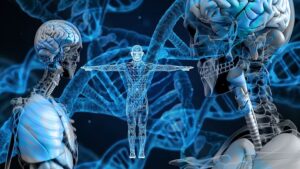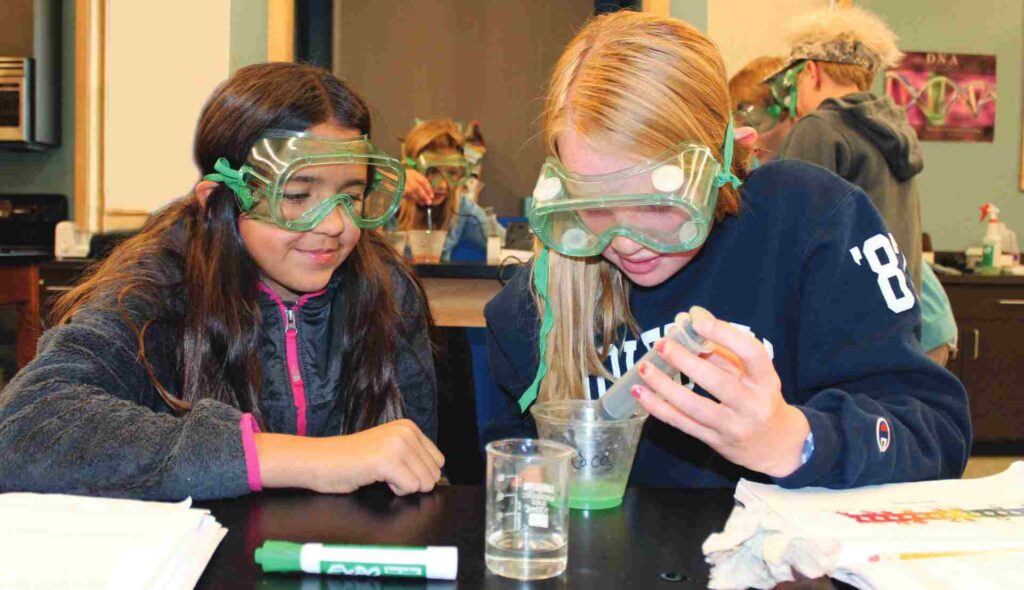How might we be more aware of how genetics and genetic engineering affect our lives?
In the spring of 2022, 8th grade science students at Mountain Academy of Teton Science Schools studied genetics and genetic engineering. This unit, Engineering Our Lives, was designed by the Place Network at Teton Science Schools. For their culminating assessment, students designed their own projects to share what they learned with people beyond our school. On the student website, you will find links to each project, which include websites, podcasts, articles, and online presentations.
This article by student Xander Vanier, provides an in-depth description of the science behind the novel biotechnology CRISPR-Cas9 and explains its possible futures and uses.
CRISPR: The Biotechnology Which Took The World by Storm, By: Xander Vanier
CRISPR (clustered regularly interspaced short palindromic repeats), a highly experimental and novel development in the scientific community, is a gene editing technology with a promising future, enabling many other intriguing and futuristic concepts like gene drives and designer babies. CRISPR is groundbreaking because a concept like it has never been heard of before. CRISPR is like a pair of scissors: it can remove any harmful genetic substance an organism has or even insert new genes. Once CRISPR locates a threatening object such as a genetic mutation, the CRISPR will go to the mutation and simply cut it out. In the past, genetic modification has been inaccurate and rarely worked properly. CRISPR is precise and exact, almost a fool-proof method of gene editing. This precision means CRISPR can cure diseases which were previously incurable. By cutting out harmful DNA, CRISPR can change the human genome, preventing biological disasters before they occur. CRISPR is the future of life itself.
CRISPR promises numerous possibilities which can potentially solve many of humanity’s most pressing issues like cancer and other genetic diseases. However, CRISPR’s past must be understood before its future becomes conceivable. CRISPR, or CRISPR-Cas9, is a gene editing function found in some bacteria which is capable of extremely specific and accurate alterations of an organism’s genes. CRISPR was discovered by Nobel Prize winners Dr. Jennifer Douda and Dr. Emmanuelle Charpentier. Emmanuelle Charpentier was the original catalyst of the discovery, however. Charpentier was analyzing Streptococcus pyogenes, the deadly bacteria which causes pneumonia, scarlet fever, and other lethal infections. While researching the pathogen, Charpentier stumbled upon tracrRNA (trans-activating CRISPR RNA), a molecule found in bacteria which is used to hold the Cas nuclease, the enzyme which cleaves DNA, in place during a genetic incision when fending off invading viruses. Charpentier released her discovery in 2011, the year she met Jennifer Doudna, a biochemist.
Doudna and Charpentier became good friends, and they began to further research the capabilities of tracrRNA and CRISPR-Cas9. To more efficiently utilize Cas9, the scientists merged crRNA, a protein which serves as the corresponding set of nucleotide bases for the target DNA, and tracrRNA. In simple terms, crRNA and tracrRNA are combined to form a larger molecule which finds the target DNA and brings Cas9 to it. The Cas9 will surround the DNA, unwind the double helix, and make a cut. Meanwhile, the tracrRNA holds the Cas nuclease in place while the edit occurs.1 The cut alerts a cell, which will immediately replace the missing nucleotide base or bases with new ones, thereby mending the mutation.2

This process, while mostly accurate, is not always completely reliable. Mistakes can be made during the editing process. For example, non homologous end binding, a procedure where Cas9 cuts more DNA than intended and creates a faulty connection, can occur. This error can possibly leave the situation worse than it began.
CRISPR-Cas9 is not only qualified for simple edits; it can also insert new, foreign genes as well as delete large portions of DNA. Currently, CRISPR-Cas9 is being tested on cancer patients and many other victims of genetic and inherited disease. CRISPR-Cas9 is being tested on many cancers like B-cell Acute Lymphoblastic Leukemia and other diseases such as Sickle Cell Anemia and Alzheimer’s Disease. 3 So far, CRISPR-Cas9 has been widely successful in its tests. Hopefully, CRISPR-Cas9 will be available for use within a matter of years.
CRISPR-Cas9 technologies are not limited to the mere curing of disease. They are also able to alter humans entirely.

Designer babies, embryos which have been genetically modified by the process of in vitro fertilization (fertilization of an egg outside of a human body) to adopt certain genetic traits or abilities, are a growing reality which scientists and bioethicists must face. Science-fiction films and literature like Gattaca have long portrayed designer baby technology as corrupting and distressing. However, these sources are extreme cases. In the near future humanity will have the technology to “design” babies and hand pick their genetic traits, interests, and characteristics. Parents will be able to shape their children into the people they desire them to be. While this may sound frightening, it should not be feared because it is already occurring. Everyday, parents shape their children by enrolling them into activities like sports and art classes. Also, parents can mold the personalities of their children by virtue of their own example.4
Designer babies are created by editing the genome of an unborn embryo using CRISPR or other methods of genetic modification. Moreover, designer babies have already been born. Some of the first designer babies were made in China by scientist He Jiankui. Jiankui was tasked with editing two sister embryos’ genomes so they could not contract HIV.5 The procedure was successful, though the identities of the children are still unknown. Jiankui, however, went to prison for three years under the conviction of performing “illegal medical practices.” He was let out of prison in early 2022.
Screening unborn children for diseases is the most common form of designer baby related tests through a procedure called preimplantation genetic diagnosis (PGD) for in vitro fertilized embryos.
In theory, designer babies could potentially eradicate diseases and assist humanity for the greater good. Eventually, the entirety of the human genome could be altered to create generally more superior beings. However, all this begs the question: is this a good thing? Should changing humanity itself be allowed? If the possible future of the world is considered with this technology in mind, what would it look like? Would it lead to a dystopian future where only the best children were allowed to live? This also brings cost into the picture. At first, designing a baby would be a complicated, expensive process in which only the wealthy could access. Could designer babies also worsen socio economic issues as well? The history of humanity proves we can be extremely destructive and malicious, but we can also do good and make positive changes. Knowing this, what will the future of humanity look like with novel technologies?6
Biotechnology companies are not only focusing on humans, but on animals as well. An emerging CRISPR-Cas9 based technology called “gene drive” is a method of genetic modification in which an edited gene is guaranteed to be passed down onto a parent’s offspring, instead of natural inheritance in which there is only a 50% chance of a gene from one parent to be passed down to the child.7 The original concept of what we now call “gene drive” was discovered by Austin Bert, a professor and geneticist.8
Gene drives are very complicated processes. First, using CRISPR, the Cas9 enzyme will be directed to a point of edit. A revision will be made, and the gene drive will be inserted with new DNA. To put it simply, the organism’s DNA now has CRISPR encoded into it, meaning it can perform edits autonomously. Thus, when an organism is reproducing, the edited parent’s chromosome will come into contact with the foreign, natural chromosome of the partner. The edited organism’s previously encoded CRISPR will scan the other chromosome for the original section of DNA, editing it. Thus, both parents carry the edited gene, ensuring the offspring will inherit it. With this technology, scientists are working on terrifically impactful projects. One of the more known and prominent uses scientists are working on is eradicating malaria.9

A species of mosquito, Anopheles, has cumulatively killed over 50 billion people. The reason: it serves as a temporary host for plasmodium falciparum, the deadly parasite which causes malaria in humans. A mosquito will contract malaria by biting a human who is already infected with the parasite. The parasite in the human’s blood will make its way into the mosquito, positioning itself in the salivary glands, ready to enter the bloodstream of another unsuspecting human victim.10
A possibility of gene drive is preventing the contraction of malaria in mosquitoes by attempting to engineer them so they cannot carry the parasite. Then, the edit would permeate through the species like water in soil due to the gene drive. This prospect could be massively positive. Imagine a world without malaria, even a world without Lyme Disease or Zika. Imagine the sheer scientific possibilities. However, this also has its issues. This discovery means humans are capable of changing an entire species. Every organism on earth is in the palm of humanity’s mighty hand, the hand which could alter life itself.
With gene drive, there are also possibilities for removing entire species from the planet. Some scientists are working on a gene drive for mosquitoes which disables the genetic code responsible for the production of eggs in females. If female mosquitoes cannot produce eggs, reproduction is impossible. If reproduction does not occur within a species, it will cease to exist. The University of California San Diego was working on a different method than disarming reproduction. Researchers were working on a more violent system where when a mosquito contracts any virus at all, the CRISPR will kill the mosquito, practically destroying it from the inside out. 11
Once again, this technology brings up many ethical questions like whether we should continue to let nature take its course, or whether we should disrupt the fragile, perfectly balanced force of life? Also, who are we to decide which species on the planet lives or dies? Consider the severity of that statement. We, humans, just another set of organisms on this planet like all the others, can decide whether billions, possibly even trillions of organisms live or die. Humans are now playing God.
Finally, I leave you with this. Humans can now change life, so the only question that remains is: should we?
____________________________________________
1“Nobel Prize in Chemistry awarded to discoverers of CRISPR-Cas9.” 12 Oct. 2020, https://www.drugtargetreview.com/news/74139/nobel-prize-in-chemistry-awarded-to-scientists-who-discov ered-crispr-cas9/. Accessed 16 May. 2022.
2“Explainer: How CRISPR works | Science News for Students.” 31 Jul. 2017, https://www.sciencenewsforstudents.org/article/explainer-how-crispr-works. Accessed 16 May. 2022.
3“Home Page | CRISPR.” http://www.crisprtx.com/. Accessed 16 May. 2022.
4“Ethics of Designer Babies | The Embryo Project Encyclopedia.” 31 Mar. 2011, https://embryo.asu.edu/pages/ethics-designer-babies. Accessed 16 May. 2022.
5“The creator of the CRISPR Babies has been released from a ….” 4 Apr. 2022, https://www.technologyreview.com/2022/04/04/1048829/he-jiankui-prison-free-crispr-babies/. Accessed 16 May. 2022.
6“Ethics of Designer Babies | The Embryo Project Encyclopedia.” 31 Mar. 2011, https://embryo.asu.edu/pages/ethics-designer-babies. Accessed 16 May. 2022.
7“Self-destructing mosquitoes and sterilized rodents: the promise of ….” 9 Jul. 2019, https://www.nature.com/articles/d41586-019-02087-5. Accessed 16 May. 2022.
8“Professor Austin Burt | Target Malaria.” https://targetmalaria.org/people/austin-burt/. Accessed 16 May. 2022.
9“Self-destructing mosquitoes and sterilized rodents: the promise of ….” 9 Jul. 2019, https://www.nature.com/articles/d41586-019-02087-5. Accessed 16 May. 2022.
10“Infection Makes Mosquitoes Immune to Malaria Parasites – National ….” 20 May. 2013, https://www.nih.gov/news-events/nih-research-matters/infection-makes-mosquitoes-immune-malaria-para sites. Accessed 16 May. 2022.
11“Self-destructing mosquitoes and sterilized rodents: the promise of ….” 9 Jul. 2019, https://www.nature.com/articles/d41586-019-02087-5. Accessed 16 May. 2022.


